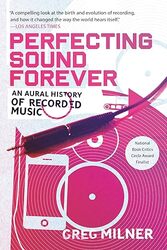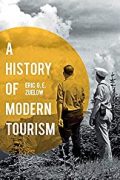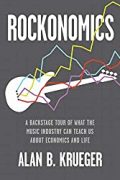
Rating: 8.2/10.
Perfecting Sound Forever: An Aural History of Recorded Music by Greg Milner
Book about the history of recorded music from the earliest audio recordings until the present day. It begins with the famous tone tests used by Edison starting around 1915 where they placed a phonograph on stage alongside a live singer and blindfolded the audience, who would be amazed that they could not tell at which point the live singer was switched out with the machine. The idea was to fool the audience into thinking that this was indistinguishable from a human singer, but they relied on some tricks from the performer to match the phonograph sound, which didn’t sound much like a human. Modern recorded music is also engineered in many ways to sound good, but what we perceive as good is often more cultural than having anything to do with live performance.
The phonograph was invented by Edison around 1888 but was initially only used for recording information, and it wasn’t until 1900 that music was used for it. Edison took a hands-on role in the beginning of marketing it and selecting the music played on it, despite being partially deaf, and conducted tone tests as a viral marketing tool from 1915 until it fell out of fashion around 1925. After the 1920s, the focus shifted away from replicating the concert experience with technology and towards new ways of making music using technology that were not previously possible, such as speakers that were louder than any human orchestra, or recording instruments separately and combining them together while adjusting their volume. Stokowski, who conducted for the Philadelphia Orchestra, was an early experimenter with these emerging technologies and worked together with Bell engineers to perfect the technology.
In folk music, Lead Belly was one of the first recorded folk musicians. John and Alan Lomax went to the Deep South Louisiana prison to find authentic “primitive” music, becoming in some sense producers for the first time for the artist. They often had different ideas of what to capture in the recordings and what to cut out. Lead Belly only became moderately successful but became influential for many later artists.
Magnetic tape promised more flexibility in sound editing and longer recording times than earlier disk formats, though there was a period where the technological capabilities weren’t quite connected yet, making it impossible to pre-record and play back over the radio in high quality. In 1940, it was assumed that all radio must be done live, and Americans were surprised at Germans having classical music play in high quality after midnight. After the war, it was discovered that the Germans had developed superior magnetic tape technology, and by 1947, Bing Crosby became one of the earliest adopters of this form of pre-recorded music.
Others began experimenting with editing capabilities and multi-track recording for the first time. The 1950s in music history introduced the first stereo and multitrack recordings, experimenting with sound effects like reverb to produce a certain room ambiance. Multiple takes could be combined together so that the final product was no longer just a recording of a live performance, although the technology was still limited in the amount of “bounces” (playing a track back and combining it with another track), without degrading quality too much, and had limited capability to undo mistakes in a relatively complex process.
This gradually improved with technological improvements such as the SSL mixing console that became popular in the 1980s. It became common to record different parts separately in a clean room to avoid different instruments bleeding into each other if performed live. These clean tracks would then be combined together with reverb effects to produce the final sound. Rather than trying to record the room of the performance, the effects of the room were added during the mixing stage, and producers were responsible for many of the sound characteristics of many famous bands of that time.
The early 1980s saw the move from analog to digital and the first CDs, which grew in popularity throughout the decade. Digital was different from analog in being a discrete signal rather than a continuous signal, so objectively there is no way to tell from a sound whether it came from a digital or analog source. Many artists claimed that the digital sound was worse, resisted the transition, and argued about the loss in fidelity, but eventually, digital won out.
With the rise of digital audio and CDs began the loudness wars of the 1990s when producers were forced to make songs sound as loud as possible, which would sacrifice dynamic range (where some parts would be quiet and some parts louder) – instead, everything had to be louder, which also caused a lot of clipping and degradation in sound quality, and producers were somewhat forced into this because if they didn’t do it, their songs would sound a lot quieter than everybody else’s. Eventually, the war reached a tipping point where radio stations increased their power levels to a point that warranted attention from the authorities, and CDs had so much clipping distortion that even casual listeners started to notice. One of the worst offenders in this area was “Californication” in 1999 by Red Hot Chili Peppers.
The Digital Audio Workstation (DAW) changed the workflow of musicians drastically, as it became possible to make heavy edits digitally, splice together clips from different takes, apply effects, and do the mixing – all within software. Pro Tools was the first widely used DAW. The history of this technology started with early FM synthesis, which was used to create sounds from scratch, but it was quite difficult to make it sound good and was confusing to musicians. It was much easier to use wavetables and sampling to record a sound and then apply effects to the recorded sound, but this was limited by the amount of memory in early computers. As this method grew in popularity, it became common for samples and loops to be shared between musicians, with the Jamaican music scene being the first group to extensively use digital effects, like King Tubby. The interface gradually evolved from the expensive Synclavier to all-in-one software that could run on Macintosh, and “Livin’ la Vida Loca” was the first major hit in 1999 that was produced end-to-end in Pro Tools.
Since then, there has been much less demand for professional recording and mixing studios, as so much of it can be done on commodity hardware. Additionally, there has been development in audio codecs that efficiently compress the signal while retaining just enough quality for listeners to not be able to tell the difference. This is evaluated through carefully conducted blind tests where listeners try to differentiate between the real and coded versions. In some sense, there is always loss when adding technology to music, there remains a niche demand for the old wax recordings that capture live performances in their purest form without any editing or effects.



